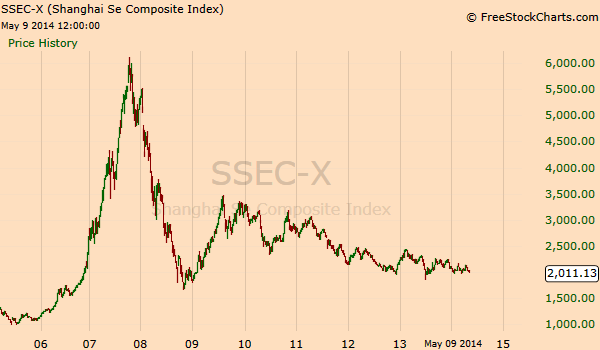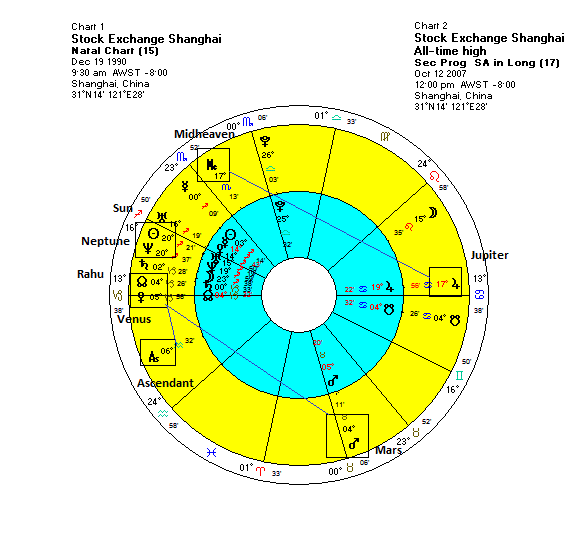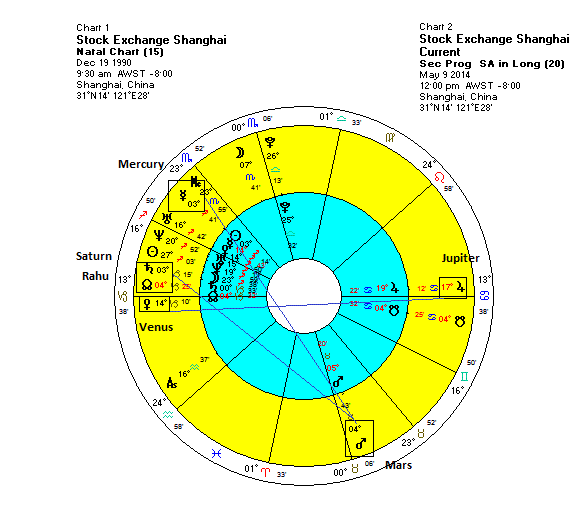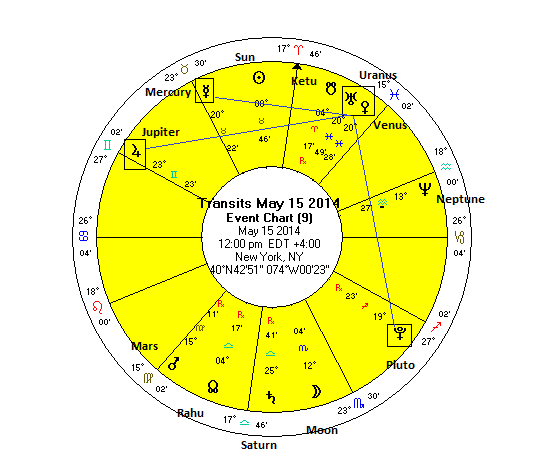 (11 May 2014) Readers of this site will know that one of my main areas of astrological interest is the stock market. While I find economics and investments inherently interesting, stock prices provide a continuous flow of data against which astrological ideas can be measured and evaluated. The stock market is therefore incredibly useful for an evidence-based astrology where changing planetary alignments can be correlated against the ups and downs in the financial markets. This is not to say any such correlations are easy or obvious since the potential number of independent variables in terms of planetary positions is almost prohibitively high. The challenge for financial astrology is to exclude mixed conditions where no clear outcome is suggested and focus instead on the smaller number of high probability planetary scenarios where clearer outcomes are more apparent.
(11 May 2014) Readers of this site will know that one of my main areas of astrological interest is the stock market. While I find economics and investments inherently interesting, stock prices provide a continuous flow of data against which astrological ideas can be measured and evaluated. The stock market is therefore incredibly useful for an evidence-based astrology where changing planetary alignments can be correlated against the ups and downs in the financial markets. This is not to say any such correlations are easy or obvious since the potential number of independent variables in terms of planetary positions is almost prohibitively high. The challenge for financial astrology is to exclude mixed conditions where no clear outcome is suggested and focus instead on the smaller number of high probability planetary scenarios where clearer outcomes are more apparent.
An an illustration of high probability alignments, we can look at the ups and downs of China’s stock market. Since unleashing the free market in 1978 under Deng Xiaoping, China’s booming economy has been a key ingredient in global economic growth. Its economic expansion reached its apex in 2007 just before the financial meltdown. At that time, the Chinese stock market reached a high of 6000 on the Shanghai Composite Index in October. Optimism had reached its maximum as domestic and foreign investors had bid up prices on stocks 500% in just the previous two years. But the meltdown changed all that as stocks crashed through most of 2008. The Shanghai Composite made a low of just 1700 in November 2008. While it rallied back up to 3500 in 2009, the Chinese market has had a fairly lackluster performance over the past four years and is now near 2000. Chinese stocks have not kept pace with the rebound in its economy in part due to restrictive government investment regulations. This is one reason why some investors have shifted money out of stocks and into the real estate market there. Whatever the economic explanation for poor stock market performance, we are more interested in whether there a clear astrological correlation for its ongoing bear market.

There is a good case to made for a simple astrological explanation using secondary progressions. This is a Western forecasting technique that is useful in accounting for longer term outcomes. A secondary progression uses a symbolic equivalence of time of planetary motion so that one day is "progressed" to one year of clock time. We can use the horoscope of the Shanghai Stock Exchange (Dec 19 1990, 9.30 a.m.) to describe the secondary progressed patterns in 2007 when the market hits its all-time high. The high occurred 17 years after the launch of the exchange (2007 – 1990=17) and thus we refer the position of the planets 17 days after its inception, which was January 5, 1991. The biwheel chart below shows how this progressed chart from Jan 5 1991 aligns with the natal chart. Not surprisingly, there are a number of favourable patterns involving natural benefic planets. Progressed Venus (5 Capricorn) is conjunct progressed Rahu (North Node) (4 Capricorn). Venus-Rahu alignments tend to be positive, especially in matters involving material things such as money and investments. One complicating factor was that both planets were 120 degrees away from Mars (4 Taurus). While Mars is a malefic planet by nature, its aspect with Venus is not full-strength and hence less damaging.

The progressed Sun (20 Sagittarius) had conjoined Neptune in 2007 and this should also be seen as a broadly positive factor in accounting to the rally in Chinese stocks. The progressed Ascendant (6 Aquarius) was also just past a 30-degree alignment with Venus-Rahu. This would have been exact the year before in 2006 during the time when stocks were soaring from 1000 to 6000. Also the progressed Midheaven (MC), the old Latin name for the 10th house cusp, was at 17 Scorpio and thus was in an exact 120 degree aspect with Jupiter (17 Cancer). So we can see that the two more bullish planets, Venus and Jupiter, were simultaneously aligned with the key progressed angles in the chart, the Ascendant and the Midheaven, at the time when the Shanghai index hit its all-time high.

If those positive alignments were close to exact at the high point of the market, it stands to reason that their eventual separation would correlate with growing weakness. Markets tend to fall not only when malefic influences are dominant but also in the wake of positive aspects. Once all those exact hits were separating, the Chinese market became more vulnerable. Progressed Venus moved away from Rahu so that left only Rahu in aspect with Mars — a decidedly negative combination.
If we fast forward to the current progressed chart, we can see that malefics predominate. Progressed Saturn (3 Capricorn) is very slowly approaching its conjunction with Rahu (4 Capricorn) while Mars remains at 4 Taurus. This is a very difficult pattern since all three planets are natural malefics. Even worse, is that Mercury (3 Sagittarius) is now part of that larger negative alignment. Although Mercury’s more positive effect might be seen as ameliorating the situation, in my experience this is rarely the case when benefics are outnumbered by malefics. The presence of Mercury with Mars, Saturn and Rahu probably makes things worse.
But the good news is that Mercury may only have to move another one degree (= one more year) to have most of this negativity manifest. By next year, Mercury will have moved past 4 Sagittarius and thus there is a chance that stocks will begin to rebound. Saturn will still be close in its alignment with Rahu and Mars of course, but there may be less bearishness. And we can see that progressed Venus (14 Capricorn) is approaching its aspect with Jupiter (17 Cancer). This will be exact in 2016 so that offers some evidence that China’s stock market is more likely to rebound after 2014. It likely will not be enough to recapture the enthusiasm of the parabolic rally of 2006-2007 but it may at least provide a break from its bear market doldrums for a while. The looming progressed Sun-Saturn conjunction is likely to undermine any major rallies, however. This Sun-Saturn conjunction will be exact in 2020 and will activate Rahu and Mars since neither planet will have moved very far in the progressed chart. This looks like another low point for the stock market in China.
Financial Markets Update
US stocks were mostly mixed last week as the market pondered more soft Chinese economic data. The Dow nonetheless closed at another all-time high at 16,583. Indian stocks fared better on anticipation of a big BJP win in the Lok Sabha elections. The Sensex climbed more 2% closing at 22,994. I thought we might have seen a little more negativity given the growing Mars and Saturn influences but it seems that Jupiter’s uplifting effects may well last into its aspect with Saturn on May 24th. While US blue chips have maintained their lofty levels in the wake of the Jupiter alignment and the Grand Cross in late April, most other stocks have declined.
This week looks more favorable given the late week conjunction of Venus and Uranus. Venus tends to have a positive effect on sentiment and this is even more likely here given the broader approximate alignment with Jupiter and Pluto. Wednesday’s alignment of the Sun, Moon and Saturn may coincide with some sober second thoughts, however.

You can be notified of new posts if you follow ModernVedAstro on Twitter.
Please note that this is a much abbreviated free version of my
investor newsletter which can be subscribed to
Please read my Disclaimer
Market forecast for week of 5 May 2014
Market forecast for week of 28 April 2014
Market forecast for week of 14 April 2014
Market forecast for week of 7 April 2014
Market forecast for week of 31 March 2014
Market forecast for week of 24 March 2014
Market forecast for week of 17 March 2014
Market forecast for week of 10 March 2014
Market forecast for week of 3 March 2014
Market forecast for week of 24 February 2014
Market forecast for week of 17 February 2014
Market forecast for week of 10 February 2014
Market forecast for week of 3 February 2014
Market forecast for week of 27 January 2014
Market forecast for week of 20 January 2014
Market forecast for week of 13 January 2014
Market forecast for week of 6 January 2014
Market forecast for week of 30 December 2013
Market forecast for week of 23 December 2013
Market forecast for week of 16 December 2013
Market forecast for week of 9 December 2013
Market forecast for week of 2 December 2013
Market forecast for week of 25 November 2013
Market forecast for week of 18 November 2013


